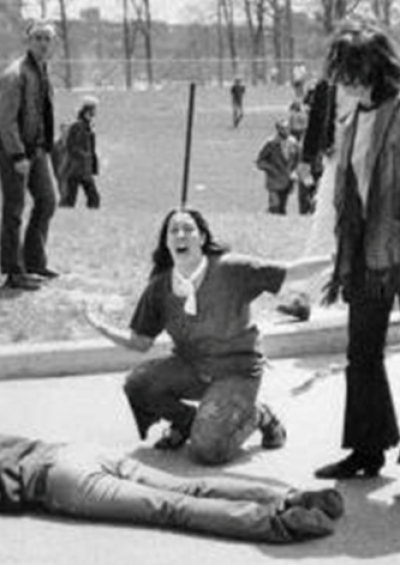50 Years After Kent State
50 years ago, on May 4, 1970, the U.S. National Guard opened fire on protesters at Kent State University. Barry Wood traveled to the campus and found somber reminders of that tragic day.

Takeaways
- On May 4, 1970, 67 shots rang out during 14 terrifying seconds. When the shooting stopped, 4 students lay dead and 9 others were wounded.
- In the days after the Kent State shooting, nearly a million students at 700 US colleges walked out of classes and marched in solidarity.
- There’s a poignancy about Kent State. Then and now Americans are shocked and ashamed at the magnitude of the tragedy.
- Sadly, what happened at Kent State could have happened at any number of campuses across the US.
- The American divide is deeper and more enduring than it has been in a long, long time.
Shortly before noon on May 4, 1970, several hundred students at Kent State University who had peacefully assembled to protest the escalation of the Vietnam war into Cambodia were ordered to disperse.
When the order by Ohio national guardsmen was ignored, the guardsmen fired tear gas and then advanced across a field to a hill where the students had gathered.
Peaceful student protest, bloody state response
At 12:34 p.m., two dozen guardsmen clustered atop the hill fired their M-1 rifles in the direction of a crowd of students. Sixty-seven shots rang out during 14 terrifying seconds.
When the shooting stopped, four students lay dead and nine other students were seriously wounded.
An iconic photo captured the moment a teenage girl realized student Jeffrey Miller was dead from a soldier’s bullet.

John Filo’s iconic photo
In the days that followed, nearly a million students at 700 U.S. colleges walked out of classes and marched in solidarity with Kent State. Nationwide, the protests swelled to four million.
That weekend, 100,000 students brought the protests to Washington where buses parked end to end and blocked off the White House. In response, elements of the 82nd U.S. Airborne Division were mobilized.
Beyond the cliché
It used to be a cliché to say that, at the time of the Kent State protests, the United States was more divided than it is today. That is no longer the case.
And it isn’t just 1960s activists like myself who have come to believe that today’s American divide is deeper and more enduring than it has been in a long, long time.
Just a specific political divide then…
Yes, there was political violence in the 1960s and, luckily, there’s been little since. The divide back then was political in nature and centered on two principal issues: The war in Vietnam and civil rights (i.e., legal improvements for African-Americans).
Subsequent progress on each of those issues ameliorated tension and diminished protests.
At its core, the anti-war movement was about young men being unwilling to fight and die in a far-away war which they opposed.
In the late 1960s, 300,000 young Americans were being drafted each year into the military. By the time the war ended, 58,000 Americans had died in southeast Asia.
Back at Kent State
Not long ago, I visited Kent State, a typical mid-level university between Cleveland and Akron. The university´s May 4th visitors center is situated in Taylor Hall, adjacent to where the shootings occurred.
The photographs and documents are riveting and somber. Outside, the landmarks and flashpoints are as they were.
There’s a poignancy about Kent State. Then and now Americans are shocked and ashamed at the magnitude of the tragedy. Sadly, you go away realizing that what happened at Kent State could have happened at any number of campuses across the country.



























